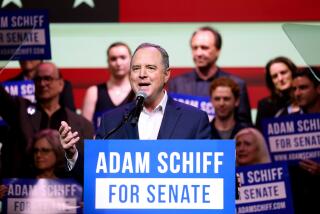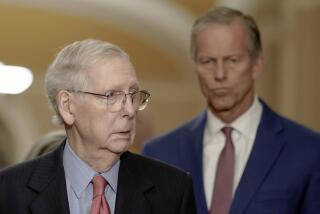‘Tea party’ gathering a tepid draw among senators
Although dozens of Republicans sailed into office with the help of the conservative “tea party” movement last year, finding a self-identified “tea party Republican” on Capitol Hill is harder than you’d think.
The first meeting of the Senate Tea Party Caucus on Thursday attracted just four senators — out of 47 GOP members — willing to describe themselves as members. The event was as notable for who wasn’t there as who was.
Sen. Marco Rubio (R-Fla.), once a tea party favorite, has for now declined to join the caucus, whose first meeting was organized by Sen. Rand Paul (R-Ky.).
Sen. Ron Johnson, a Wisconsin Republican whose campaign sprung from the small-government movement, has said he’s unsure if he’ll join. Sen. Pat Toomey (R-Pa.) showed up to address the group of activists, but then hustled out of the room, ignoring reporters’ questions about whether he was in or out.
The reluctance shows how the purposefully disjointed movement and its crop of outspoken and controversial leaders, although a powerful force in the campaign that spurred Republicans to a big midterm victory, are still viewed as risky allies even for conservative politicians.
With the rhetoric of the campaign now translating into debate over politically painful budget cuts, the tea party agenda looks less like the hub of Republican energy in Congress and more like an endpoint of the spectrum.
To be sure, there are institutional reasons for the Senate Tea Party Caucus’s still-meager membership — which, for now, at least, is outnumbered by the Coast Guard Caucus. In the House, special-interest caucuses serve as a way for like-minded lawmakers to amplify their influence. But in the Senate, which has fewer members, the tactic is less necessary and senators are less eager to join.
The Senate also has a stricter pecking order and more defined set of expectations for new members. So it was fairly unusual when, after just a few weeks in office, Paul proposed his own budget. He recommended gutting the Interior and State departments, eliminating the Department of Energy and cutting all funding for public radio and television and for the National Endowment for the Arts.
Though Paul’s plan would cut $500 billion from the budget in a year — five times what GOP leaders in the House have proposed — even some fiscally conservative Republicans have not been quick to endorse it.
A spokesman for Rubio, a former Florida state lawmaker who defeated Republican Gov. Charlie Crist in a three-way race for the Senate seat, said the senator hadn’t read it. Rubio’s plan for revamping education contains no specific program cuts.
Paul’s approach — bold, specific and unwaveringly conservative — is exactly what the most engaged activists of the tea party have been seeking. One of the biggest applause lines at Thursday’s meeting came when staunch conservative Sen. Jim DeMint (R-S.C.) quoted Paul as saying: “My goal is to make DeMint look like a moderate.”
But it’s not necessarily a pragmatic approach for lawmakers like Rubio or Johnson, who need to attract support from independent and even Democratic voters in their swing states.
Johnson said he was declining to join the Tea Party Caucus because it threatened to highlight division within the Republican Party.
“The reason I ran for the U.S. Senate was to not only stop the Obama agenda but reverse it. I believe our best chance of doing that is to work towards a unified Republican conference, so that’s where I will put my energy,” said Johnson, who noted that he had “great respect for the tea party movement.”
There’s evidence of similar reservations in the House, where many more new Republicans were helped by tea party activism.
More than 50 Republicans joined the House Tea Party Caucus in July, during the campaign season. A membership list for the new Congress will be released in February, according to the office of the caucus founder and chairwoman, Rep. Michele Bachmann (R-Minn.).
But several new Republicans in the House have said they’re uncertain whether they’ll join the caucus, citing worries about demands on their time and an early focus on constituent services.
“I’m amazed at how many different directions I’m being pulled,” said Rep. Steve Southerland (R-Fla.). “I represent an incredibly diverse district. There’s a lot of different political persuasions, a lot of different groups. I want to make sure that I represent all of my district, not just one group.”
Others expressed concerns about aligning behind Bachmann. Like Paul, Bachmann has sought to stand out as a leader among conservatives in Congress. However, she has alienated some with her verbal gaffes and tendency to seek out the spotlight.
Her televised response to President Obama’s State of the Union speech — on behalf of the Tea Party Express and separate from the official GOP response — was met with mixed reviews and criticized by some as muddling the Republican message.
“Invitations would be viewed more favorably if it were led by someone else,” said one aide to a Republican lawmaker who had tea party support during the campaign. “I think lots of people have their fingers in the air, looking to see where this goes.”
Bachmann and Sen. Mike Lee (R-Utah), who along with Paul, DeMint and Sen. Jerry Moran (R-Kan.) joined the Senate caucus, have sought to answer such concerns by billing the meetings as listening sessions rather than strategy sessions.
“The word ‘caucus’ is a blunt instrument. I think people think it will be a faction of some sort,” Lee said. “But this is simply a group of senators who are going to hold meetings from time to time with people who agree with the tea party movement.”
On Thursday, some of the grass-roots activists expressed frustration with the small number of lawmakers who joined the caucus, as well as with Paul’s budget proposal — which, in their view, did not go far enough.
kathleen.hennessey@latimes.com
More to Read
Get the L.A. Times Politics newsletter
Deeply reported insights into legislation, politics and policy from Sacramento, Washington and beyond. In your inbox three times per week.
You may occasionally receive promotional content from the Los Angeles Times.







